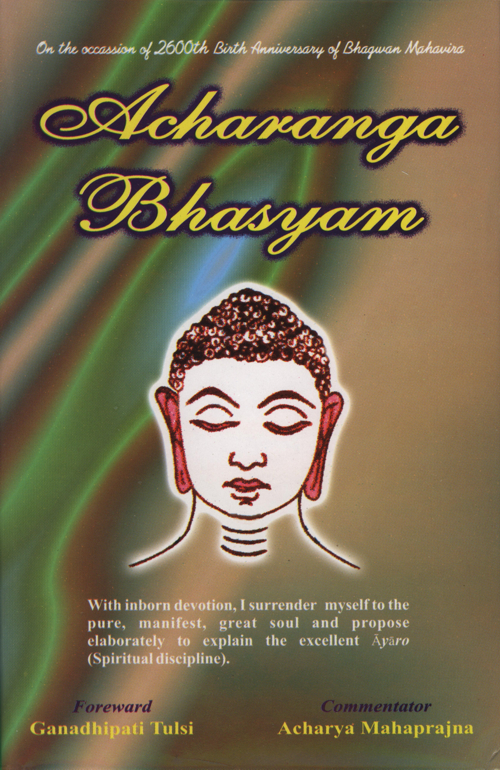1.66 se bemi - ṇeva sayaṃ logaṃ abbhāikkhejjā, ṇeva attāṇaṃ abbhaikkhejjā. je logaṃ abbhāikkhai, se attāṇaṃ abbhāikkhai. je attāṇaṃ abbhāikkhai, se logaṃ abbhāikkhai.
One should neither deny the world (of fire-bodied beings), nor should one deny oneself. One who denies the world (of fire-bodied beings), denies himself and one who denies himself, denies the world (of fire-bodied beings). Thus do I say.
Bhāṣyaṃ Sūtra 66
Here 'world' means the world of fire-bodied beings.[1] Although the fire-bodied beings are not visible on account of their being very subtle, even then the Niryukti has adduced some arguments in order to prove their existence.
Even as the corporeal mass of the glow-worm shines as light in the night, exactly so the lighting power in the fire is inferred as originating from a particular transformation in the fire-bodied beings. Even as the heat of fever is not separate from the fevered, exactly so on account of its heat (temperature), fire is also inferred as a variety of living being.[2]
In the Vṛtti [3] also, the following argument is given in favour of fire as a sentient entity. Fire grows on the supply of fuel, and diminishes and extinguishes in the absence of it.
Modern thinkers admit that fire cannot kindle without the intake of oxygen.
The fire-bodied beings are entities distinct from other types of sentient beings, on account of their specific body-determining karma, viz., heat-producing and lustre-producing.
The rest is like Sūtra 39.
1.67 je dῑhaloga-satthassa kheyaṇṇe, se asatthassa kheyaṇṇe. je asatthassa kheyaṇṇe, se dῑhaloga-satthassa kheyaṇṇe.
One who knows the weapon of (injury to) the world of long-bodied beings (plants), knows the nature of non-weapon (self-restraint). One who knows the non-weapon, knows the weapon of (injury to) the world of long- bodied beings.
Bhāṣyaṃ Sūtra 67
The world of long-bodied beings refers to the vegetation world. It is so called because its body is long in size, and in respect of quantity of its substance it is infinite; the plant is in the world of long-lived beings as it is born repeatedly in a similar body for a long time. This meaning is available in the Cūrṇi and Vṛtti. But in the Daśavaikālika,[4] 'the world of long-bodied beings' stands for all kinds of living beings, namely the earth-bodied and the like. Fire is the weapon of injury to that world. The person who is conversant with this is a knowledgeable person and he alone is conversant with the meaning of non-weapon or self-restraint. The implication is that such person alone can abstain from injury to fire-bodied beings. It can also be said that the person who has the knowledge of self-restraint (and the mode of life that avoids the weapons of injury) is one who comprehends the nature of the weapon injurious to the world of long-bodied beings.[5]
1.68 vῑrehiṃ eyaṃ abhibhūya diṭṭhaṃ, saṃjatehiṃ sayā jatehiṃ sayā appamattehiṃ.
By cutting down their veils of knowledge of intuition, the heroes, who are always self-restrained, self-controlled and wakeful have realised the reality of the fire-bodied beings.
Bhāṣyaṃ Sūtra 68
The heroes have directly experienced[6] all these facts about the fire-bodied beings by cutting down the veils covering their power, knowledge and intuition by means of white (pure) meditation. Here, there is no clear indication of what has been cut down. But the word 'realise' obviously implies the cutting down of the veils of knowledge and intuition, which leads to direct experience.
Hero: Capable of overcoming the veils.
Self-restrained: Restrained in respect of the objects of senses and mind. Always self-controlled: Established in self-control on account of their controlling the passions of anger, pride, etc.
Always wakeful: Always vigilant towards pure consciousness.
There are four means of cutting down the veils, e.g., spiritual vigour, self-restraint, self-control and wakefulness. Alone those who are self-restrained, self-controlled and wakeful are the heroes who are capable of cutting down the veils.
abhibhūya—In the Sūtrakṛtāṅga Sūtra, 1/6/5, we get the text abhibhūyaṇāṇῑ. It corroborates our interpretation. Even in the present canon (5/111), we get the text abhibhūya adakkhu. There also, it carries the same spirit.
The Cūrṇi has given several interpretations of the word 'adakkhu' - "cattāri ghāikammāṇi abhibhūta, parῑsahā uvasagge ya abhibhūya, ahavā jahā āicco gahaṇakkhattatārāṇaṃ prabhaṃ abhibhūya bhāti tathā chaumatthiyanāṇāṇaṃ abhibhūya sadevamaṇuyāsurāe parisāe majjhayāre parititthie abhibhūya.........(Ācārāṅga Cūrṇi, pp.29,30)
Pātañjalayogadarśanānusāreṇa vyutthānasaṃskārāṇāmabhibhave sati nirodhasaṃskārāṇaṃ prādurbhāvo jāyate. (Pātañjalayogadarśana, vibhūtipāda, sūtra 8).
 Acharya Mahaprajna
Acharya Mahaprajna

